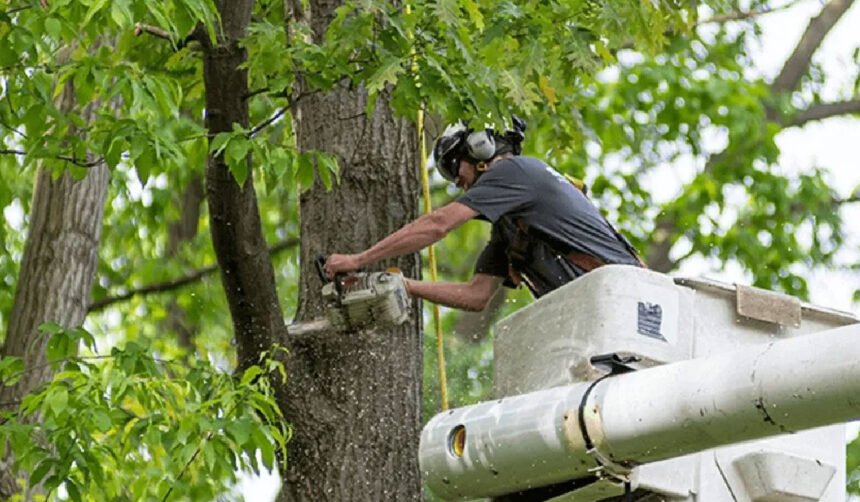Introduction
Trees are a vital part of our ecosystems and properties. They provide shade, improve air quality, support wildlife, and enhance curb appeal. However, not all trees are assets forever. Sometimes, they become liabilities—posing safety risks, interfering with structures, or declining in health. In such cases, tree removal becomes a necessary and responsible decision.
Tree removal is a significant undertaking. It goes beyond just cutting a trunk and dragging away debris. It’s about evaluating risk, understanding tree health, using the proper tools, ensuring safety, and planning for the future of your landscape. Whether you’re a homeowner, property manager, or developer, knowing when and how to remove a tree is crucial.
In this detailed guide, we will explore the reasons for tree removal, the step-by-step process, safety considerations, cost factors, and post-removal care, giving you a full understanding of how to manage trees on your property wisely.
Why Tree Removal Becomes Necessary
Trees can live for decades or even centuries, but not all of them thrive forever. Here are some common reasons why removing a tree might be essential:
1. Safety Hazards
Dead or dying trees can pose a serious threat to people, buildings, and vehicles. Unstable branches or trunks may fall without warning, especially during storms or strong winds.
2. Diseased or Infested Trees
Trees affected by pests like termites or diseases such as root rot may deteriorate internally before showing visible signs. These weakened structures can collapse unexpectedly.
3. Interference with Property
Overgrown roots can damage foundations, driveways, and plumbing systems. Canopies may block sunlight, interfere with power lines, or pose hazards to roofs and gutters.
4. Landscaping or Construction Projects
New construction or landscaping designs often require clear space. Removing select trees can allow for better layouts and site planning while reducing future maintenance.
5. Aesthetic and Environmental Management
Sometimes, trees grow in unsuitable locations, compete with other plants, or block desired views. Removing a tree in these cases helps maintain balance and visual appeal.
Assessing the Tree Before Removal
Before initiating removal, it’s critical to evaluate the tree carefully. A qualified arborist can inspect the tree to assess its health and structure. This includes:
- Checking for signs of decay or cavities
- Examining the lean and balance of the trunk
- Inspecting roots and soil condition
- Identifying dead or broken limbs
- Assessing pest infestation levels
In some situations, pruning, bracing, or treating the tree may be sufficient. However, if the tree poses a high risk or cannot be saved, removal is typically recommended.
Planning the Tree Removal Process
Tree removal isn’t a spontaneous job. It requires methodical planning to avoid injury, property damage, and legal issues.
Step 1: Permit and Regulation Check
In many areas, tree removal is regulated. Permits may be required, especially for trees of a certain size, age, or species. Failing to comply with regulations can lead to fines.
Step 2: Determine the Right Time
The ideal time for tree removal is during dormancy, usually in late fall or winter, when leaves are gone and branches are lighter. However, hazardous trees should be removed immediately, regardless of season.
Step 3: Safety Preparation
Before cutting begins, secure the area. Remove any obstacles like furniture, vehicles, or landscape features. Safety gear, including helmets, goggles, gloves, and harnesses, should always be used.
Step 4: Tool and Equipment Checklist
Professional removal often requires:
- Chainsaws
- Ropes and pulleys
- Climbing harnesses
- Ladders or aerial lifts
- Wood chippers
- Stump grinders
Tree Removal Methods
Depending on the tree’s size, location, and surroundings, professionals choose one of several removal techniques.
1. Straight Felling
This involves cutting the tree at its base and allowing it to fall in a controlled direction. It’s only feasible in open areas with sufficient space.
2. Sectional Dismantling
In confined spaces, trees are taken down in sections. Arborists climb and cut the tree limb by limb, lowering each piece safely to the ground using ropes and rigging systems.
3. Crane-Assisted Removal
When trees are large or pose too much risk to nearby structures, cranes may be used to lift and remove sections. This is often the safest and most efficient method for urban areas.
What Happens After the Tree Is Down?
Cutting down the tree is only part of the job. The following steps ensure the area is clean and ready for future use.
1. Branch and Log Disposal
Branches are chipped or hauled away, while logs may be cut for firewood, recycled into mulch, or removed entirely.
2. Stump Removal
Leaving the stump can cause regrowth, attract pests, or create tripping hazards. Options include:
- Stump grinding: A fast, effective method that grinds the stump below ground level.
- Complete removal: Extracting both the stump and roots, usually necessary for replanting or construction.
3. Soil Restoration
After stump removal, the hole should be filled with soil, leveled, and optionally replanted with grass, shrubs, or a new tree.
Cost Factors of Tree Removal
Tree removal costs vary significantly based on several key factors:
- Tree height and diameter: Larger trees require more labor and equipment.
- Tree condition: Dead or decaying trees are more hazardous and costly to handle.
- Location: Trees near buildings, fences, or power lines are more complex to remove.
- Access: Hard-to-reach locations may require cranes or additional crew.
- Stump removal: This adds to the overall cost.
On average, homeowners can expect to pay anywhere from a few hundred to several thousand dollars depending on the complexity.
Environmental Impact and Responsible Removal
Tree removal should always be approached with environmental responsibility in mind. Trees are habitats for wildlife and important for carbon capture, so consider:
- Planting replacement trees elsewhere on your property
- Choosing native species better suited to local conditions
- Consulting with arborists to remove only what’s necessary
Recycling wood into mulch, using logs for firewood, or donating timber to local artisans can also minimize waste.
DIY vs. Professional Tree Removal
While small tree trimming may be manageable, full-scale tree removal is a job best left to professionals. The risks of injury, property damage, and legal liability are high without proper training and tools.
Professionals offer:
- Certified expertise
- Proper equipment
- Insurance coverage
- Faster, cleaner results
Hiring a licensed tree removal service also ensures compliance with local regulations and safe disposal practices.
Post-Removal Landscape Planning
Once the tree is removed, the area can be transformed into something new. Consider:
- Planting a new tree with better placement
- Installing a garden bed or water feature
- Creating a shaded patio or seating area
- Expanding lawn or play areas
Planning with purpose allows the removal to become a step forward in your property’s long-term beauty and utility.
The Role of Preventative Care
Tree removal can often be avoided with good tree health management. Regular pruning, soil care, watering, and pest control help trees thrive and stay structurally sound. Annual inspections by an arborist can catch issues early, offering solutions before removal becomes the only option.
Conclusion
Trees are essential for both ecological and personal well-being. Yet, when they become a threat or hindrance, tree removal is sometimes the only safe and practical choice. Whether driven by safety, construction, or health concerns, the process requires thoughtful planning, proper equipment, and skilled execution.
Understanding when to remove a tree—and how to do so responsibly—empowers property owners to make smart decisions for their landscapes and communities. With the right approach, the end of one tree can become the beginning of new possibilities.
For More Information, Visit Dotmagazine









